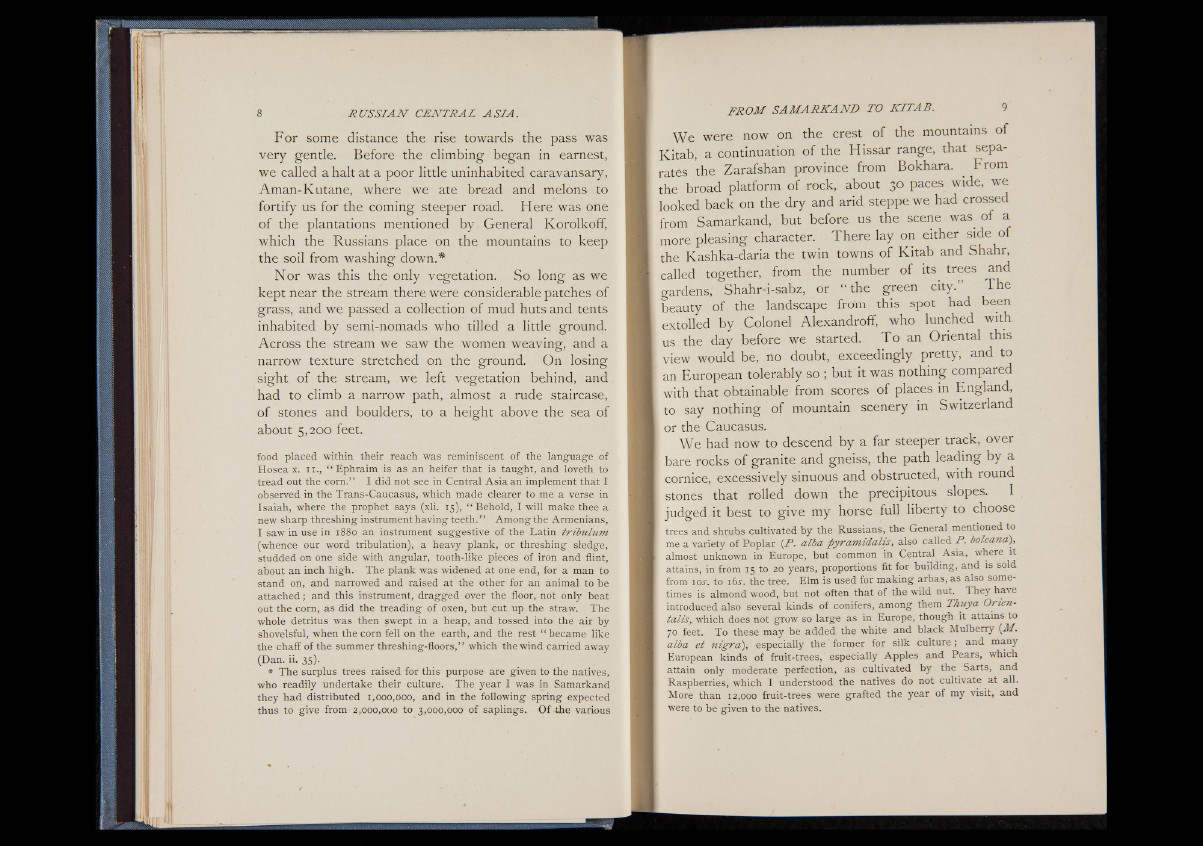
For some distance the rise towards the pass was
very gentle. Before the climbing began in earnest,
we called a halt at a poor little uninhabited caravansary,
Aman-Kutane, where we ate bread and melons to
fortify us for the coming steeper road. Here was one
of the plantations mentioned by General Korolkoff,
which the Russians place on the mountains to keep
the soil from washing down.*
Nor was this the only vegetation. So long as we
kept near the stream there were considerable patches of
grass, and we passed a collection of mud huts and tents
inhabited by semi-nomads who tilled a little ground.
Across the stream we saw the women weaving, and a
narrow texture stretched on the ground. On losing
sight of the stream, we left vegetation behind, and
had to climb a narrow path, almost a rude staircase,
of stones and boulders, to a height above the sea of
about 5,200 feet.
food placed within their reach was reminiscent of the language. of
Hosea x. 11., “ Ephraim is as an heifer that is taught, and loveth to
tread out the com.’ ’ I did not see in Central Asia an implement that I
observed in the Trans-Caucasus, which made clearer to me a verse in
Isaiah, where the prophet says (xli. 15), “ Behold, I will make thee a
new sharp threshing instrument having teeth.” Among the Armenians,
I saw in use in 1880 an instrument suggestive of the Latin tribulum
(whence our word tribulation), a heavy plank, or threshing sledge,
studded on one side with angular, tooth-like pieces of iron and flint,
about an inch high. The plank was widened at one end, for a man to
stand on, and narrowed and raised at the other for an animal to be
attached; and this instrument, dragged over the floor, not only beat
out the com, as did the treading of oxen, but cut up the straw. The
whole detritus was then swept in a heap, and tossed into the air by
shovelsful, when the corn fell on the earth, and the rest “ became like
the chaff of the summer threshing-floors,” which thewind carried away
(Dan. ii. 35).
* The surplus trees raised for this purpose are given to the natives,
who readily undertake their culture. The year I was in Samarkand
they had distributed 1,000,000, arid in the following spring expected
thus to give from 2,000,000 to 3,000,000 of saplings. Of the various
We were now on the crest of the mountains of
Kitab, a continuation of the Hissar range, that separates
the Zarafshan province from Bokhara. From
the broad platform of rock, about 30 paces wide, we
looked back on the dry and arid steppe we had crossed
from Samarkand, but before us the scene was of a
more pleasing character. There lay on either side of
the Kashka-daria the twin towns of Kitab and Shahr,
called together, from the number of its trees and
gardens, Shahr-i-sabz, or “ the green city.” The
beauty of the landscape from this spot had been
extolled by Colonel Alexandroff, who lunched with
us the day before we started. T o an Oriental this
view would be, no doubt, exceedingly pretty, and to
an European tolerably so ; but it was nothing compared
with that obtainable from scores of places in England,
to say nothing of mountain scenery in Switzerland
or the Caucasus.
We had now to descend by a far steeper track, over
bare rocks of granite and gneiss, the path leading by a
j cornice, excessively sinuous and obstructed, with round
stones that rolled down the precipitous slopes. I
judged it best to give my horse Tull liberty to choose
trees and shrubs cultivated by the Russians, the General mentioned to
me a variety of Poplar (P. alba fyramidalis, also called P. boleana),
almost unknown in Europe, but common in Central Asia, where it
attains, in from 15 to 20 years, proportions fit for building, and is sold
from 10s. to 16s. the tree. Elm is used for making arbas, as also sometimes
is almond wood, but not often that of the wild nut. They have
introduced also several kinds of conifers, among them Thuya Orien-
talis, which does not grow so large as in Europe, though it attains to
70 feet. To these may be added the white and black Mulberry [M.
alba et nigral), especially the former for silk culture; and many
European kinds of fruit-trees, especially Apples and Pears, which
attain only moderate perfection, as cultivated by the Sarts, and
Raspberries, which I understood the natives do not cultivate at all.
More than 12,000 fruit-trees were grafted the year of my visit, and
were to be given to the natives.